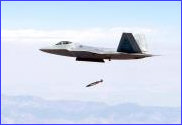EDWARDS AIR FORCE BASE, Calif., June 12, 2006 --
A U.S. Air Force F-22 Raptor air dominance fighter, flying at a speed of Mach 1.5 and an altitude of 50,000 feet, released a GPS-aided Joint Direct Attack Munition (JDAM) from a range of 24 nautical miles, destroying a small ground target in the F-22's fastest and highest JDAM delivery yet.

An F/A-22 Raptor, flown by Maj. John Teichert, releases a guided bomb unit-32 1,000-pound joint direct attack munitions at supersonic speed for the first time in an earlier test. [U.S. Air Force photo by Darin Russell]
This was another milestone testing event for the Combined Test Force of Lockheed Martin, The Boeing Company and U.S. Air Force pilots who conducted the joint developmental and operational test in early May at White Sands Missile Range, N.M., using a 1,000-pound Mk-83 JDAM with live warhead supplied by Nellis Air Force Base, Nev. The ability to release a munition at supersonic speeds and standoff ranges greatly enhances the aircrew's survivability against heavily defended targets.
“We've already demonstrated the airplane's ability to operate with virtual impunity in the air-to-air realm and have had many successful JDAM deliveries previously, but successfully attacking a ground target at this speed, altitude and standoff range with a live weapon shows that to be true in the air-to-ground mission as well,” said pilot Lt. Col. Raymond “Buzz” Toth following the test. “The Raptor is ready to fight and is uniquely capable of supporting Air Force and Joint Command objectives against any enemy.”
Success of the standoff delivery is due in part to the Raptor avionics' ability to compute and display an accurate Launch Acceptability Region (LAR), the area in the sky from which the pilot can release a weapon to successfully attack the desired target. The LAR supersonic algorithm, developed by a Boeing collaboration of F-22, Phantom Works and JDAM engineers, factors in navigation, weather, target and weapon information.
“The LAR algorithm developed by this interdisciplinary team offers the robust capability of updating to the latest weapon performance without requiring a new software build,” said Paul Bay, vice president and F-22 program manager at Boeing. “Our JDAM, Phantom Works and F-22 units each brought a specialized expertise that was essential to making the LAR integration a success.”
"The successful drop of the JDAM from the Raptor has demonstrated our Systems Engineering process throughout the design life cycle,” said John E. Paquet, director, F-22 Mission Systems and Software at Lockheed Martin. “Early in the design phase, we brought Raptor pilots to the high fidelity air combat simulator and received valuable feedback on the new JDAM LAR. We were able to quickly incorporate their feedback into the software design, and the results of that collaborative effort were evident in the recent test."
The F-22 is capable of dominating any adversary through an unmatched combination of stealth, supercruise speed, agility and precision strike, together with a complete view of the battlespace provided by an advanced sensor suite and integrated avionics. The Raptor will enable combat commanders to change the way wars are fought over the next 40 years.
Prime contractor Lockheed Martin has delivered 71 F-22s to the Air Force, with 107 Raptors on contract. The fighter is currently assigned to four bases across the United States:
- Testing is conducted at Edwards AFB, Calif.
- Tactics development takes place at Nellis AFB, Nev.
- Pilots and maintenance teams receive training at Tyndall AFB, Fla.
- Operational F-22s of the 1st Fighter Wing are assigned to two squadrons at Langley AFB, Va.
A GPS-aided near-precision weapon, the JDAM guidance kit is capable of guiding inventory bombs ranging from 500 to 2,000 pounds. JDAM has been used extensively in global operations by the U.S. Air Force and Navy. Since 1998, Boeing has produced more than 140,000 JDAM guidance kits for the U.S. and 15 international customers.
The F-22 Raptor, the world's most advanced 5TH Generation fighter, is built by Lockheed Martin in partnership with Boeing and Pratt & Whitney. Parts and subsystems are provided by approximately 1,000 suppliers in 42 states. F-22 production takes place at Lockheed Martin Aeronautics facilities in Palmdale, Calif.; Meridian, Miss.; Marietta, Ga.; and Fort Worth, Texas; as well as at Boeing's Seattle, Wash. plant. Final assembly and initial flight-testing of the Raptor occurs at the Marietta plant facilities.
